3.0 – 5 Speed 1993 – 1996 / 3.2 – 6 Speed 1996 – 1999

M – A very powerful letter
Issue date: 6/04/2010 / Revised: 19/04/2020
3.0 – 5 Speed S50 B30
Coupe 03/93 through 07/95 (1914 UK Registered)
Saloon 12/94 through 07/95 (424 UK Registered)
Convertible 09/94 through 08/95 (602 UK Registered)
(Production figures provided by BMW GB)
Introduction to the E36 3.0 Coupe #
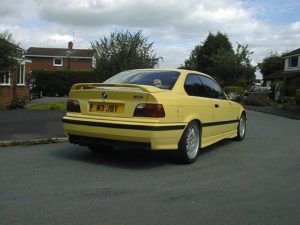 The E36 M3 3.0 is the original BMW MotorSport (later called BMW M) version of the E36 3 Series. Available as a coupe, convertible or saloon, it uses one of two 3.0-litre S50 engines, both based to some degree on the standard production M50 Engine. The UK (& European) S50 has individual throttle bodies and a more complex cylinder head, while the U.S.-spec S50 more closely resembles the normal production M50 engine.
The E36 M3 3.0 is the original BMW MotorSport (later called BMW M) version of the E36 3 Series. Available as a coupe, convertible or saloon, it uses one of two 3.0-litre S50 engines, both based to some degree on the standard production M50 Engine. The UK (& European) S50 has individual throttle bodies and a more complex cylinder head, while the U.S.-spec S50 more closely resembles the normal production M50 engine.
All E36 M3s also have a BMW M-tuned chassis and unique cosmetic items both inside and out. Unlike its E30 M3 predecessor, the E36 M3 was not designed primarily for competition use, but rather as a road-going GT car.
The E36 M3 coupe was first shown at the 1992 Paris Motor Show. The U.S.-spec version did not appear until the 1994 Los Angeles International Auto Show.
All 3.0-litre E36 M3s were built on the regular 3 Series assembly line at the Regensburg factory near Munich with the exception of a small batch of coupes assembled in South Africa from German-supplied Semi Knocked-Down kits during late 1993 and early 1994 exclusively for that market
BMW initially produced the European-spec E36 M3 3.0 only as a coupe. Convertible and Saloon versions were introduced two years later. Each body style was offered in left-hand drive and right-hand drive configurations. There was also a limited run of E36 M3 GT coupes built in both left-hand drive and right-hand drive.
Special Editions #
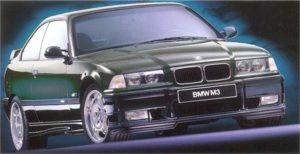 The E36 M3 GT Individual is a special edition of 50 right-hand drive E36 M3 coupes produced exclusively for the UK market in July of 1995. Though mechanically identical to the standard M3, the E36 M3 GT Individual received all the same exterior cosmetic enhancements as the left-hand drive E36 M3 GT: British Racing Green (312) paintwork, adjustable front and rear GT spoilers, clear front turn signal lenses and forged M Double Spoke alloy wheels (7.5×17-in. front, 8.5×17-in. rear). The interior also received the same Mexico Green Nappa leather + Anthracite Amaretta upholstery as the M3 GT, though the carbon fibre interior trim was replaced by Graphite Birds Eye Maple wood (including the shift knob) and chrome interior door handles were also fitted. Finally, each E36 M3 GT Individual received the M strut tower brace, as well as a three-spoke steering wheel, power sunroof, and onboard computer. Nineteen examples were further equipped with air conditioning, while nine received aluminium doors.
The E36 M3 GT Individual is a special edition of 50 right-hand drive E36 M3 coupes produced exclusively for the UK market in July of 1995. Though mechanically identical to the standard M3, the E36 M3 GT Individual received all the same exterior cosmetic enhancements as the left-hand drive E36 M3 GT: British Racing Green (312) paintwork, adjustable front and rear GT spoilers, clear front turn signal lenses and forged M Double Spoke alloy wheels (7.5×17-in. front, 8.5×17-in. rear). The interior also received the same Mexico Green Nappa leather + Anthracite Amaretta upholstery as the M3 GT, though the carbon fibre interior trim was replaced by Graphite Birds Eye Maple wood (including the shift knob) and chrome interior door handles were also fitted. Finally, each E36 M3 GT Individual received the M strut tower brace, as well as a three-spoke steering wheel, power sunroof, and onboard computer. Nineteen examples were further equipped with air conditioning, while nine received aluminium doors.
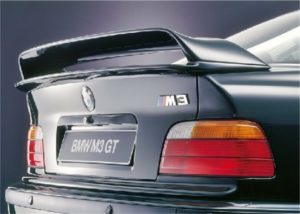
3.2 6 speed S50 B32 – The Evolution
Coupe 01/96 through12/98 (2268 UK Registered)
Saloon, 01/96 through 12/97 (1901 UK Registered)
Convertible 02/96 through 07/99 (670 UK Registered)
(Production figures provided by BMW GB)
Introduction to the 3.2 Evolution #
For the 1996 model year, BMW M replaced the E36 M3 3.0 with the faster and more refined 3.2-litre version. For the European market, this model was fitted with the new S50 B32 engine, an evolution of the S50 B30, as well as a six-speed manual gearbox and detailed refinements to the chassis. For the U.S. (and later Canadian) market, the M3 received its own engine, the S52, plus ASC+T traction control and a host of chassis upgrades. Both versions were also treated to a few cosmetic alterations.
 The 3.2-litre E36 M3 was first shown at the 1995 Frankfurt Motor Show. The North American-spec version did not appear until the 1996 New York International Auto Show.
The 3.2-litre E36 M3 was first shown at the 1995 Frankfurt Motor Show. The North American-spec version did not appear until the 1996 New York International Auto Show.
All 3.2-litre E36 M3s were built on the regular 3 Series assembly line at the Regensburg factory near Munich, with the exception of a small batch of M3 3.2 sedans built in BMW’s Rosslyn, South.
 The E36 M3 3.2 was immediately produced in a coupe and convertible form, as well as a four-door sedan. Like the original 3.0-litre E36 M3, 3.2-litre models were equipped with two different engines, one for North America (S52) and a second for Europe and the rest of the world (S50 B32). The latter model was offered from the start in all three body styles and in both left-hand drive and right-hand drive configurations. Of these, a small run of right-hand drive sedans was assembled in South Africa from German-supplied components in late 1996, and a further number were fully built there during 1997 and 1998.
The E36 M3 3.2 was immediately produced in a coupe and convertible form, as well as a four-door sedan. Like the original 3.0-litre E36 M3, 3.2-litre models were equipped with two different engines, one for North America (S52) and a second for Europe and the rest of the world (S50 B32). The latter model was offered from the start in all three body styles and in both left-hand drive and right-hand drive configurations. Of these, a small run of right-hand drive sedans was assembled in South Africa from German-supplied components in late 1996, and a further number were fully built there during 1997 and 1998.
UK Special Editions #
The Imola Individual (Fondly Known as the GT2, my old one pictured above ;0) was introduced in 1998 as a Special Edition by BMW GB to Commemorate the end of E36 M3 production
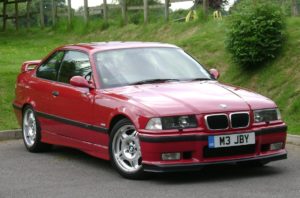
50 UK-market M3 coupes were produced in late 1998. Although mechanically identical to the standard model, these were all painted Imola Red (405) and featured the complete M3 GT-spec rear spoiler with third brake light, Front Class II Splitters and the forged M Double Spoke alloy wheels.
The interior was trimmed in Bi-colour Imola Red leather with Anthracite Amaretta suede bolsters and was equipped with a special M steering wheel featuring red stitching on the rim.
 Similar stitching appeared on the parking brake handle. All examples were further equipped with side airbags, power sunroof, power front seats, power rear vent windows and the Harmon/Kardon audio system.
Similar stitching appeared on the parking brake handle. All examples were further equipped with side airbags, power sunroof, power front seats, power rear vent windows and the Harmon/Kardon audio system.
What to look out for #
Engine #
An obvious this to look out for is the dreaded often talked about Vanos Unit. The 3.0 Has a Single Vanos, and the Evo’s have a twin Vanos system, problems usually show around 45,000 Miles. The Solenoids can leak, the seals fail, or the gears can wear, or fail and leave you with noise from the unit similar to marbles rattling around in there.
The Vanos issue is well documented on the internet now as the cars are getting to 20 years old and older.
I replaced a unit on my own S50 engine and used Mr Vanos, who is well known for sorting Vanos units. They supply and fit a fully rebuilt unit, with all the seals, solenoids and pistons replaced. This is fitted with modified cam gear plates and once done they expect it to last the life of the car. They also check the valve clearances as the cams have to come out to change the gears. New valve cover gaskets are also fitted.
They also offer 3 years warranty on the unit and a lifetime warranty against any Vanos noise, and all this can be done at your home for £895.
I also got a quote to sort my unit from Hack Engineering, which was circa £1100 to essentially “sort the Vanos” but this needed to be done at their garage. Historically I have seen BMW warranty bills for £2200, so Mr Vanos at £865 represented good value and a simple solution for my particular situation.
The Lambda Sensors can cause running problems like lumpy tick over, and over fuelling (low mpg’s), and they burn out around 60K and there are usually 2 of them,
The engines are usually bulletproof but check for overly noisy injectors, oil leaks, evidence of misuse, ensure all lids, and wires are as they should be, and check the oil and water levels, before and after the test drive.
The engine has a little oil pressure valve that can start to leak over time, I’ve had 3 done out of the cars I’ve owned so far, not the end of the world, but it may be worth getting it checked out, and fixed if found.
Transmission #
Manual #
Watch for wear on the 2nd gear Syncro on of the manual box as they can get worn when previous owners have been snatching 2nd gear in the 0-60 dash, replacing a Syncro on a box is usually going to be a replacement box, which is fine if you get a cheap second-hand box from someone on-line like Fab Direct, or Quarry Motors. BMW used to charge close to £2,000 exchange, so check that you are happy on the test drive.
A clutch will cost you a good £350 – £500 to fit + the price of the clutch, if the car has between 75K and 100K most are ready for a clutch, unless you are lucky, or if it’s already had one.
There is a common fault with most M3’s that everyone knows, but here it is, As the cars get older the hydraulic clutch pipe can expand, meaning the clutch can drag, a new pipe, or a braided updated pipe from eBay or other websites is often a cheap fix. Though doesn’t always solve the issue unless your old one was really swelling. If you change the pipe yourself, get advice from a BMW Garage on bleeding the clutch as my friend did his last week and it was a nightmare!!
His advice “The bleed nipple is on the bottom so perfectly adequate to bleed fluid through but not to remove air, this usually means a pressure bleed tool or unbolting the slave and rotating it to get the nipple at the top and either uses the “Bavarian tool” to stop the piston popping out to bleed it or work the piston by hand”
SMG: Sequential Manual Gearbox #
The Evolution was supplied with the very clever SMG Gearbox, Check oil levels for the hydraulic system, as if it’s low it will pop out of gear, can suddenly select neutral when driving and give the occasional error code on the dash. When warm get the car in sport mode (not manual) and drive it hard through the gear range, ensure the clutch doesn’t slip.
This system will fail over time, the pump can fail, the gear position sensor can fail, along with the fact it relies on a secondary ECU and a bulk load of other components means troubleshooting a failed unit takes time and money, and there are fewer specialists around who will be able to help you. Many are now getting converted back to manual as it’s a quite simple task as the car is set up to be a manual car already, as well as being registered as a manual on the V5 registration documents too.
Rust #
BMW’s aren’t usually too bad for rust, and most M3’s if you’re lucky have been looked after, if not, look for rust in the following places:
- The front edge and side seams of the bonnet
- Rear arches
- Around the BMW badges
- Boot lid around the boot lock barrel, behind the boot handle, bottom edge inside and out, especially near the corners and drain holes and look for splits/cracks around the boot catch screw holes, usually indicating the boot catch has fatigued and broken away from the mount to the third screw hole.
- Inside the boot under the boot seals near the lights
- Around the jacking rubber points.
Rear Arches: Check the rear arches for signs of rust, as they hold mud and rot from the inside out, especially if mud and wet gets behind the plastic covers and sticks to the inside of the wheel arches.
You can buy arch sections for about £80.00 but cost me £500 to have them fitted.
Suspension #
A common well-known issue is the rear Shocker top mounts as they wear out, check by lifting the car up and down via rear arch, listen for knock, don’t be confused with the half shafts catching though, you can remove the inside trim and bounce the car looking for excessive movement in the rubbers. They are not too dear to replace so just get a set, various companies do stiffer ones, but beware as it does make a difference to the ride, you can hear more road noise through the car for example.
I’ve used Rouge Engineering updated units in the past, they were £80.00 but they wouldn’t need replacing again any time soon, and a feature of them is you can remove the rear shocks without going in the car as the nuts can be bolted up from inside the wheel arch.
The rubbers on the rear trailing arms tend to need replacing circa 75K Get a garage to check for you, you can usually tell if it slides about a bit too much at the rear under heavy acceleration or deceleration. The front control arms are best checked; if they are worn you may experience wandering steering.
Be wary about uprated the suspension above standard, as it changes the ride characteristics of the car, it can make it quite stiff (unless that’s what you’re going for) as a good mechanic once told me ‘BMW spent a lot of money developing and testing the suspension for the M3 cars, so why go changing it?’
Tyres #
Go for a good set of tyres, as after all, it’s what connects the car to the road, I’d buy Michelin Pilot Sports, as they handle best in my opinion. You’re looking at £600 for a full set at last purchase.
I believe M3’s had Michelin Pilot Sports or some Dunlop options from the factory, so I like to keep as close to the way BMW intended the car to drive. I’ve tried Avon’s, Continentals and Pirelli, but always come back to the Michelin’s, they are a well-balanced tyre for wear, performance and wet & dry grip, again in my opinion. Make sure they are the correct size for the car, as shown on the sticker on the driver’s door area by the door catch.
Wheels #
if they have diamond-cut alloys most refurbisher’s will not touch them, as the lacquer comes straight off again at the slightest chip, and also if they are damaged BMW charge a lot for a new one (used to be £400 + Vat if you can get one. BMAutosport does a good selection of refurbished alloys usually with tyres, don’t skimp on cheap wheels as they set the whole car off in my opinion.
Be careful getting them from eBay sight unseen as you can never really tell how good they are unless you get good pictures, I’ve been caught out myself on occasion. If the car is not too far away, most owners will be happy for you to view the car before bidding.
Brakes #
The M3 Evolution features compound discs in a floating arrangement on the front axel, so if they have been replaced with aftermarket discs take note as the floating hub style is circa £250 each, but there are after-market examples, and again the internet is a wealth of knowledge on which to try. I always ought OEM, but there is a premium for these.
Fuel & Brake Lines #
Check on the condition of metal fuel and brake lines that run under the passenger floor front to rear, as well as the flexible lines that attach to the callipers, where the metal reduces in thickness near the tightening clamp.
The rear brake pipes run over the petrol tank, so replacing them can be a bit of a job. I’ve paid £300 for the job, my mate was recently quoted £175 for his 328, so still not chicken feed.
Exhaust #
The OEM rear boxes are quite expensive, and so are the cats, so check for rust, and blowing. Check the welds on the front and rear of the cat mount where they mount to the exhaust pipe, check for blows and cracks.
On the Evo there is a flexible piece on one of the manifold downpipes that can crack and leak, they are very expensive to replace on the EVO, and aftermarket ones are not much cheaper than OEM. The last time I checked they were circa £1000.
Note: Aftermarket exhausts tend to be too noisy, like the scorpion type as they drone at motorway cruising speeds, Milltek do some good performance bits I believe, but not cheap, £750 for a cat-back system, sports cats are circa £900.
Electronics #
It is best to check all switchgear. Make sure all switches do what they should do especially in the case of special equipment like heated seats, or uprated sound such as HK speaker systems.
Check that the windows go all the way up automatically on the full switch press, if not the units that control the window stop (as it feels resistance for safety) may have gone, which is a pain as they won’t close unless you hold down the switch, and full closure alarms may not be able to close the window, nor can you on the key.
The Brake Circuit Warning will usually come on at some point in the cars life, this is just usually a switch that resides on the brake pedal. Not an expensive job.
In my many years of M3 ownership, the electrics haven’t really let me down, only when an alarm system had been incorrectly fitted, which can also drain your power, or interfere with remote central locking operation.
Check the battery is the correct size, as often the larger, more powerful batteries are replaced by smaller, inferior units.
Body #
Check that the bonnet catches are not too new, as these often get replaced on front end shunts. Check inner wing seam welds, should be neat and match each other, make sure all original BMW stickers are on the front slam panel and inner wings. Make sure that the bumper lines up, as after shunts they can be loose or uneven.
Look for signs of paintwork, usual spots are round the edges of the windscreen rubbers, under the rear lights on the rear 1/4 where the 1/4 meets the rear panel (See picture below), and inside the fuel filler area.

As well as against any rubber area where a paint line will or could have been sprayed up to. (E.g. the ¼ Rear Window Rubbers)
Trim #
The M Sport mouldings have metal inside them, these rust and the clips break off, ensure all mouldings are close to the body of the car. Clips can be bought BMW, but note the side mouldings on the doors are really tight and require a good brave strike to get them to clip in place.
BMW still sell a lot of the original mouldings and clips for the cars but be aware they are starting to creep up in price, as the cars are getting older, and the stockpiles of parts are being depleted.
For most of the original black mouldings, you can bring them back to life with a good plastic restorer (I use race glaze colour enhance)
Two areas that usually let the car down are the rear ¼ window seals as they perish, it is a simple job to replace them, the one along the ¼ window edge is attached with double-sided sticky tape.
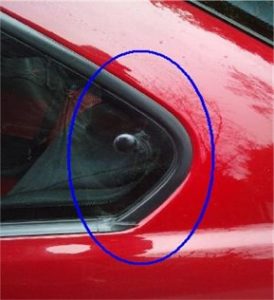
You can also replace the trim/rubber around the rear window, as the bottom edges perish, this makes the car look a lot fresher, it’s tricky unless you remove the rear screen, but with heat, Fairy liquid and patience it’s possible.
(See pictures below of before and after)


The Door rubbers are expensive to replace if they are split. Also, they could have been letting in moisture, check under the sill trim as you get in the car, like the holes where the plastic trim fits the sill can trap water and rust.
Whilst in this area, check the edges of the M3 sill mouldings as if they have perished again you might want to consider replacing them.
One final thing is the front Evo lip on the M-Tec spoiler, replacing one can make the front of the car look refreshed. Check the attachment to the front bumper, as the clips get damaged, sometimes people use self-tapping screws to attach the lips directly to the bumper which can make a mess.
Boot Catches #
Check the boot catch, as if the car has a spoiler they make the boot heavy, and over constant slamming the internal support can crack, causing the boot to flex on the two remaining mounting screws, which over time tears the boot, and causes not only damage but an annoying squeak. (See pictures below)


Air Conditioning #
Ensure the AC blows cold as the AC system is expensive to fix if there’s a leak in the condenser unit, up to £500, and they are not an easy DIY job. Then there’s the dryer and the actual AC Pump. If the outside temperature is too cold the ac doesn’t run, this is a feature)
Of course, you could be lucky, and if the AC’s not up to scratch a simple re-gas may cure it @ £40 – £80 depending on the supplier. I use “cool my car” from Deeside. Very good at £60.
Keys #
I believe M3s, from 94 onwards, have chip encoded keys that have to be programmed to match the car, so if you only have one key then it can be expensive, just think the cost of the key plus at least an hour’s BMW labour to code it up. (If in doubt call your local dealer).
Running Costs #
Another consideration in purchasing an M3 is the running costs. M3’s carry group 20 insurance, so check this before setting your heart on one. The next thing that can be a shock to the pocket is the service costs, @ March 2010, BMW for example charge the following for servicing a 1998 M3; Oil Service – £160, Inspection 1- £800 and Inspection 2 – £1400 so not so cheap if you’re buying a £6000 car.
Your local garage can obviously service the car, and there are lots for good independents out there, I paid £200 for my last inspection 1 service, for example, just beware, that although the M3’s have come right down in price, they were still a £40,000+ Motor car, and as such can carry heavy parts bills.
Foot Note #
As with any car purchase, it is a case of buyer beware, when viewing a potential purchase approach with eyes wide open, especially given the age. Specialists in the marque are able to provide a pre-purchase report. You can always look at getting an AA/RAC Type report as they are very thorough, but remember the MOT covers a fair few points if correctly completed.
You can also view past MOT information and advisory notices online with the document code of the V5. The MOT also tells you if there was an advisory, in case the previous owner omitted to show you it.
M3s and BMW E36s in general are prone to the previous owner’s tastes, which may cost a good chunk of money if you wish to revert to standard, like alloys, subwoofers, extra wiring, exhausts, de-cat pipes, car badges and stickers. Be aware of all this, especially if the car has a dodgy alarm that could cause major electric issues in the future.
M3s have been known to fall into the wrong hands, get an HPI / V-Car check to ensure it’s not been damaged, stolen, or has finance owing on it.
As the second-hand market generally is very strong for classic cars at the moment and motorsport marques seem to be on the rise, the E36 M3 still represents one of the best ways to get into a practical classic at a sensible price point, and as such the prices of clean examples are commanding a premium, and consequently owners of more beaten up examples are also asking for high premiums. Just take your time when looking for a car, make sure it represents value for money for you and what you are trying to get out of ownership be it a weekend show car, a garage queen or a fun car you can run out with your mates, and throw around a race track, either way, they are a great car to own.
Credits:
http://www.bmwmregistry.com – Great FAQ site for M Power Cars used for the Model info for this guide
http://www.m3gtregister.com – Site Dedicated to E36 M3 Special Editions.





You must be logged in to post a comment.